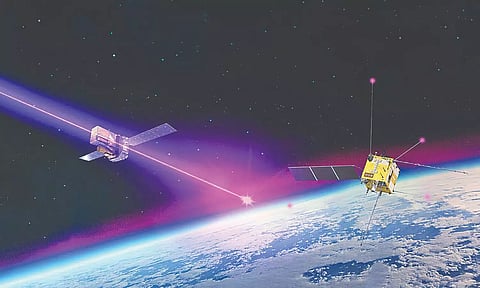

By Katrina Miller
NEW YORK: On Oct. 9, 2022, telescopes in space picked up a jet of high energy photons careening through the cosmos toward Earth, evidence of a supernova exploding 1.9 billion light-years away. Such events are known as gamma ray bursts, and astronomers who have continued studying this one said it was the “brightest of all time.” Now, a team of scientists have discovered that this burst caused a measurable change in the number of ionized particles found in Earth’s upper atmosphere, including ozone molecules, which readily absorb harmful solar radiation.
“The ozone was partially depleted — was destroyed temporarily,” said Pietro Ubertini, an astronomer at the National Institute of Astrophysics in Rome who was involved in discovering the atmospheric event. The effect was detectable for just a few minutes before the ozone repaired itself, so it was “nothing serious,” Dr. Ubertini said. But had the supernova occurred closer to us, he said, “it would be a catastrophe.” The discovery, reported in a paper, demonstrates how even explosions that occur far from our solar system can influence the atmosphere, which can be used as a giant detector for extreme cosmic phenomena.
Most atmospheric ozone is concentrated in a thin layer of the stratosphere, about 10 to 25 miles above Earth’s surface. It was in this region that researchers discovered a hole in the ozone above Antarctica, largely resulting from the use of chemicals called chlorofluorocarbons that were once found in aerosol sprays and plastic foam. The ozone layer absorbs most of the ultraviolet radiation from our sun that can cause sunburns, skin cancer and crop damage.
Simulations have shown that a gamma ray burst in our Milky Way could wipe out the stratospheric ozone layer for years, long enough to cause widespread extinction. Ozone also exists at lower concentrations higher up in the ionosphere, a part of the atmosphere that stretches from 37 to 310 miles altitude. At those altitudes, it has some protective effect, but much less than at lower heights.
To study the effects of last year’s gamma ray burst on Earth, Dr. Ubertini and his colleagues looked for signals at the top of the ionosphere using data from the China Seismo-Electromagnetic Satellite, an orbiter designed to study changes in the atmosphere during earthquakes. They identified a sharp jump in the electric field at the top of the ionosphere, which they correlated to the gamma ray burst signal measured by the European Space Agency’s International Gamma-Ray Astrophysics Laboratory, a mission that launched in 2002 to observe radiation from faraway celestial objects.
The researchers found that the electric field rose by a factor of 60 as gamma rays ionized (essentially knocking away electrons from) ozone and nitrogen molecules high in the atmosphere. Once ionized, the molecule is unable to absorb any ultraviolet radiation, temporarily exposing Earth to more of the sun’s damaging rays.
Gamma ray bursts have been known to ionize molecules at the bottom of the ionosphere, up to about 215 miles above Earth’s surface. But this is the first time scientists have proved that cosmic explosions like this can affect the entire ionosphere, according to Laura Hayes, a solar physicist at the European Space Agency who was not involved in the study.